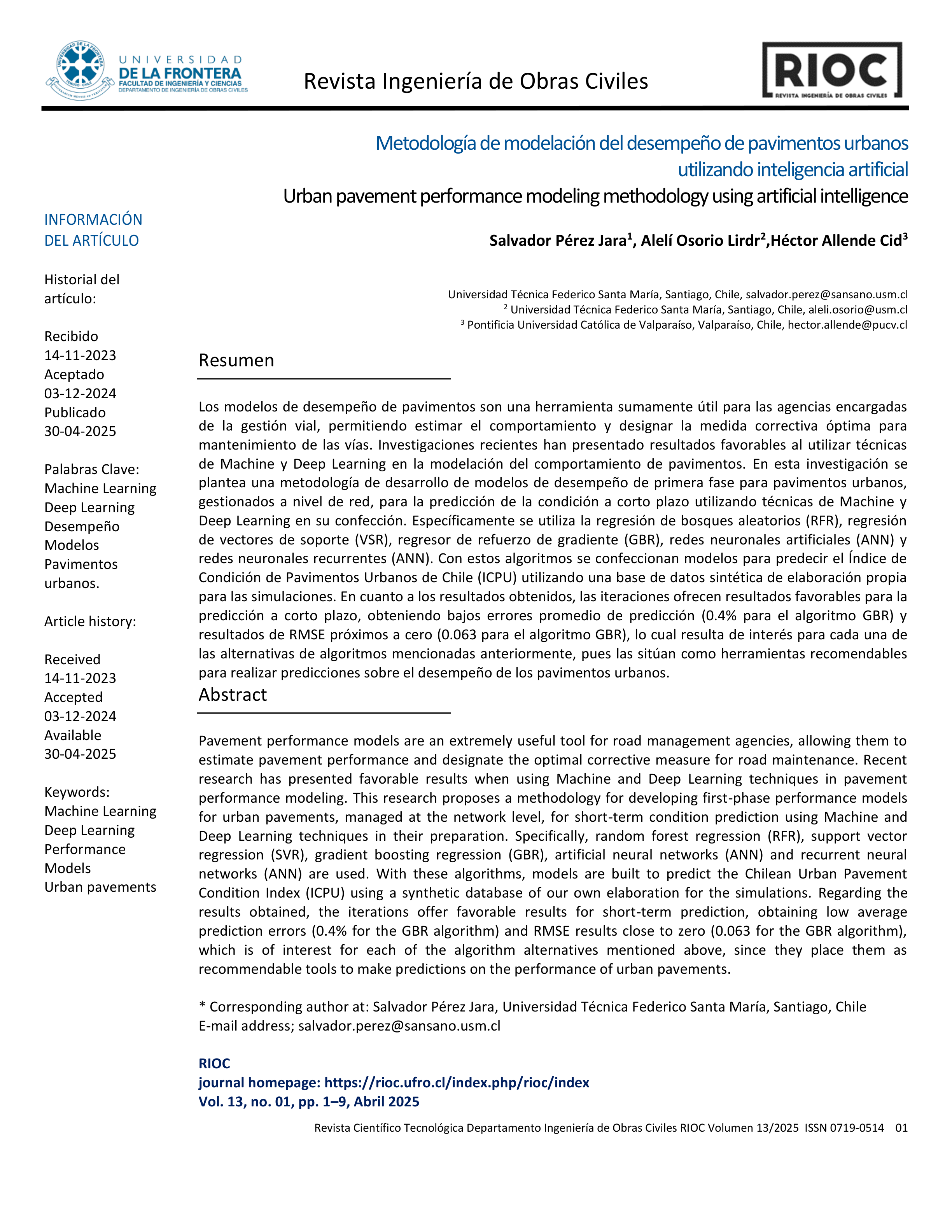Metodología de modelación del desempeño de pavimentos urbanos utilizando inteligencia artificial
Palabras clave:
Machine Learning, Deep Learning, Desempeño Modelos, Pavimentos urbanosResumen
Los modelos de desempeño de pavimentos son una herramienta sumamente útil para las agencias encargadas de la gestión vial, permitiendo estimar el comportamiento y designar la medida correctiva óptima para mantenimiento de las vías. Investigaciones recientes han presentado resultados favorables al utilizar técnicas de Machine y Deep Learning en la modelación del comportamiento de pavimentos. En esta investigación se plantea una metodología de desarrollo de modelos de desempeño de primera fase para pavimentos urbanos, gestionados a nivel de red, para la predicción de la condición a corto plazo utilizando técnicas de Machine y Deep Learning en su confección. Específicamente se utiliza la regresión de bosques aleatorios (RFR), regresión de vectores de soporte (VSR), regresor de refuerzo de gradiente (GBR), redes neuronales artificiales (ANN) y redes neuronales recurrentes (ANN). Con estos algoritmos se confeccionan modelos para predecir el Índice de Condición de Pavimentos Urbanos de Chile (ICPU) utilizando una base de datos sintética de elaboración propia para las simulaciones. En cuanto a los resultados obtenidos, las iteraciones ofrecen resultados favorables para la predicción a corto plazo, obteniendo bajos errores promedio de predicción (0.4% para el algoritmo GBR) y resultados de RMSE próximos a cero (0.063 para el algoritmo GBR), lo cual resulta de interés para cada una de las alternativas de algoritmos mencionadas anteriormente, pues las sitúan como herramientas recomendables para realizar predicciones sobre el desempeño de los pavimentos urbanos.
Descargas

Descargas
Publicado
Cómo citar
Número
Sección
Licencia
Derechos de autor 2025 Salvador Pérez Jara, Alelí Osorio Lirdr, Héctor Allende Cid

Esta obra está bajo una licencia internacional Creative Commons Atribución 4.0.
Los autores/as que publiquen en esta revista aceptan las siguientes condiciones:
- Los autores/as conservan los derechos de autor y ceden a la revista el derecho de la primera publicación, con el trabajo registrado con la licencia de atribución de Creative Commons, que permite a terceros utilizar lo publicado siempre que mencionen la autoría del trabajo y a la primera publicación en esta revista.
- Los autores/as pueden realizar otros acuerdos contractuales independientes y adicionales para la distribución no exclusiva de la versión del artículo publicado en esta revista (p. ej., incluirlo en un repositorio institucional o publicarlo en un libro) siempre que indiquen claramente que el trabajo se publicó por primera vez en esta revista.
- Se permite y recomienda a los autores/as a publicar su trabajo en Internet (por ejemplo en páginas institucionales o personales) antes y durante el proceso de revisión y publicación, ya que puede conducir a intercambios productivos y a una mayor y más rápida difusión del trabajo publicado (vea The Effect of Open Access).



